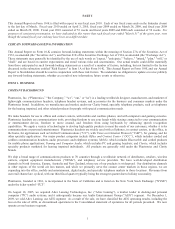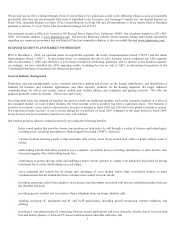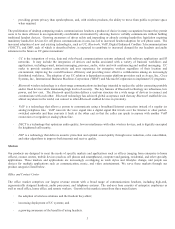Plantronics 2010 Annual Report Download - page 19
Download and view the complete annual report
Please find page 19 of the 2010 Plantronics annual report below. You can navigate through the pages in the report by either clicking on the pages listed below, or by using the keyword search tool below to find specific information within the annual report.11
A significant portion of our profits comes from the office and contact center markets. We experienced a meaningful decline in
demand in these markets and a further decline could materially adversely affect our results. The economic conditions described above
have resulted in a severe contraction of business spending which resulted in a drop in revenues of all our OCC products in fiscal 2009
and fiscal 2010 in comparison to fiscal 2008. In addition, the economic conditions have also resulted in a reduction in the
establishment of new contact centers and in capital investments to expand or upgrade existing centers which has negatively affected
our business. We are not able to predict when economic conditions will improve or when an increase in the establishment of new
contact centers or an increase in capital investments in contact centers may occur. Because of our reliance on the contact center
market, we have been more affected by changes in the rate of contact center establishment and expansion and the communications
products used by contact center agents than would a company serving a broader market. Any further decrease in the demand for
contact centers and related headset products will cause a further decrease in the demand for our products which will materially
adversely affect our business, financial condition and results of operations.
Further, fluctuations in foreign currency exchange rates impact our revenues and profitability because we report our financial
statements in U.S. Dollars, whereas a significant portion of our sales to customers are transacted in other currencies, particularly the
Euro and the Great Britain Pound (“GBP”). We hedge a portion of our Euro and GBP forecasted revenue exposure for the future 12
month period. Although we have employed these hedging techniques to minimize these risks, we can offer no assurance that such
strategies will be effective. Over the past three-month period, the value of the Euro and the GBP against the U.S. Dollar has declined
by approximately 10% and 6%, respectively. If the Euro and GBP continue to fall against the U.S. Dollar or if the current exchange
rates continue, our revenues, gross profit and profitability in the future could be negatively affected. See also our risk titled “We are
exposed to fluctuations in foreign currency exchange rates which may adversely affect our revenues, gross profit, and profitability.”
Failure to meet our anticipated demand projections could create excess levels of inventory, which would result in additional reserves
for excess and obsolete inventory, negatively impacting our financial results.
Our operating results are difficult to predict, and fluctuations may cause volatility in the trading price of our common stock.
Given the nature of the markets in which we compete, our revenues and profitability are difficult to predict for many reasons,
including the following:
x Our operating results are highly dependent on the volume and timing of orders received during the quarter, which are
difficult to forecast. Customers generally order on an as-needed basis, and we typically do not obtain firm, long-term
purchase commitments from our customers. As a result, our revenues in any quarter depend primarily on orders booked
and shipped in that quarter.
x We incur a large portion of our costs in advance of sales orders because we must plan research and production, order
components and enter into development, incur sales and marketing expenditures, and other operating commitments prior
to obtaining firm commitments from our customers. In the event we acquire too much inventory for certain products, the
risk of future inventory write-downs increases. In the event we have inadequate inventory to meet the demand for
particular products, we may miss significant revenue opportunities or incur significant expenses such as air freight, costs
for expediting shipments, and other negative variances in our manufacturing processes as we attempt to make up for the
shortfall. When a significant portion of our revenue is derived from new products, forecasting the appropriate volumes
of production is even more difficult.
Fluctuations in our operating results may cause volatility in the trading price of our common stock.
























